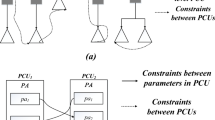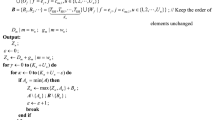Abstract
Product configuration, a widely used technology in product family design, is one of the most effective technologies of mass customization strategies which have been deployed by many companies for years. Nevertheless, the mass customization needs to cover the management of the whole customizable product cycle. In order to assist the development of mass customization, it is essential to extend the configuration technology to product family process planning, which is the technological essence of process configuration. In this article the process configuration task is confirmed based on the analysis of characteristics of process planning. Compared with the solving scheme of product configuration, the process configuration is then mapped into a generative constraint satisfaction problem (GCSP), and the variables and constraints of the process configuration GCSP model are identified respectively. An algorithm based on backtracking algorithm is introduced to complete the process configuration. Finally, an experiment on machining process configuration for satellite plate panel verifies the validity of our algorithm.








Similar content being viewed by others
References
Aldanondo, M., & Vareilles, E. (2008). Configuration for mass customization: How to extend product configuration towards requirements and process configuration. Journal of Intelligent Manufacturing, 19(5), 521–535.
Barták, R., Salido, M. A., & Rossi, F. (2010). Constraint satisfaction techniques in planning and scheduling. Journal of Intelligent Manufacturing, 21(1), 5–15.
Brown, D. C. (1998). Defining configuring. AI EDAM, 12(04), 301–305.
Campagna, D., & Formisano, A. (2013). Product and production process modeling and configuration. Fundamenta Informaticae, 124(4), 403–425.
Felfernig, A., Friedrich, G., Jannach, D., Silaghi, M., & Zanker, M. (2003). Distributed generative CSP approach towards multi-site product configuration. In Workshop on immediate applications of constraint programming (ACP) (pp. 100–123).
Felfernig, A., Hotz, L., Bagley, C., & Tiihonen, J. (2014). Knowledge-based configuration: From research to business cases. MA: Morgan Kaufmann.
Fujita, K., Amaya, H., & Akai, R. (2013). Mathematical model for simultaneous design of module commonalization and supply chain configuration toward global product family. Journal of Intelligent Manufacturing, 24(5), 991–1004.
Jannach, D., & Zanker, M. (2013). Modeling and solving distributed configuration problems: A CSP-based approach. Knowledge and Data Engineering, IEEE Transactions on, 25(3), 603–618.
Jiao, J. R., Simpson, T. W., & Siddique, Z. (2007). Product family design and platform-based product development: A state-of-the-art review. Journal of Intelligent Manufacturing, 18(1), 5–29.
Jiménez, P. (2013). Survey on assembly sequencing: A combinatorial and geometrical perspective. Journal of Intelligent Manufacturing, 24(2), 235–250.
Laborie, P. (2003). Algorithms for propagating resource constraints in AI planning and scheduling: Existing approaches and new results. Artificial Intelligence, 143(2), 151–188.
Mayer, W., Thiagarajan, R., & Stumptner, M. (2009) Service composition as generative constraint satisfaction. In Web Services, 2009. ICWS 2009. IEEE International Conference on, 2009 (pp. 888–895). IEEE.
Mencía, C., Sierra, M. R., & Varela, R. (2014). Intensified iterative deepening A* with application to job shop scheduling. Journal of Intelligent Manufacturing, 25(6), 1245–1255.
Pitiot, P., Aldanondo, M., & Vareilles, E. (2014). Concurrent product configuration and process planning: Some optimization experimental results. Computers in Industry, 65(4), 610–621.
Pitiot, P., Aldanondo, M., Vareilles, E., Gaborit, P., Djefel, M., & Carbonnel, S. (2013). Concurrent product configuration and process planning, towards an approach combining interactivity and optimality. International Journal of Production Research, 51(2), 524–541.
Schierholt, K. (2001a). Process configuration: Combining the principles of product configuration and process planning. AI EDAM, 15(05), 411–424.
Schierholt, K. (2001b). Process configuration: Mastering knowledge-intensive planning tasks. vdf Hochschulverlag AG, ETH Zurich.
Smith, S., Smith, G. C., & Jiao, R. (2013). Mass customization in the product life cycle. Journal of Intelligent Manufacturing, 24(5), 877–885.
Stumptner, M. (1997). An overview of knowledge-based configuration. Ai Communications, 10(2), 111–125.
Stumptner, M., Friedrich, G. E., & Haselböck, A. (1998). Generative constraint-based configuration of large technical systems. AI EDAM, 12(4), 307–320.
Stumptner, M., & Haselböck, A. (1993). A generative constraint formalism for configuration problems. In Advances in artificial Intelligence (pp. 302–313). Berlin, Heidelberg: Springer.
Wang, Y., & Tseng, M. M. (2013). A Naïve Bayes approach to map customer requirements to product variants. Journal of Intelligent Manufacturing. doi:10.1007/s10845-013-0806-2.
Wu, D., Zhang, L. L., & Jiao, R. J. (2013). SysML-based design chain information modeling for variety management in production reconfiguration. Journal of Intelligent Manufacturing, 24(3), 575–596.
Yang, D., & Dong, M. (2013). Applying constraint satisfaction approach to solve product configuration problems with cardinality-based configuration rules. Journal of Intelligent Manufacturing, 24(1), 99–111.
Zanker, M., Jannach, D., Silaghi, M. C., & Friedrich, G. (2008). A distributed generative csp framework for multi-site product configuration. In Cooperative information agents XII (pp. 131–146). Berlin, Heidelberg: Springer.
Zhang, L., & Rodrigues, B. (2010). Nested coloured timed Petri nets for production configuration of product families. International Journal of Production Research, 48(6), 1805–1833.
Zhang, L. L. (2007). Process platform-based production configuration for mass customization. Doctoral dissertation, Nanyang Technological University, Singapore.
Zhang, L. L., Xu, Q., Yu, Y., & Jiao, R. J. (2012). Domain-based production configuration with constraint satisfaction. International Journal of Production Research, 50(24), 7149–7166.
Acknowledgments
This work was supported by the National Natural Science Foundation of China (No. 51405104), the Research Fund for the Doctoral Program of Higher Education of China (No. 20112302130003) and the Research Innovation Fund of Harbin Institute of Technology (No. IDGA18102049).
Author information
Authors and Affiliations
Corresponding author
Rights and permissions
About this article
Cite this article
Wang, L., Zhong, SS. & Zhang, YJ. Process configuration based on generative constraint satisfaction problem. J Intell Manuf 28, 945–957 (2017). https://doi.org/10.1007/s10845-014-1031-3
Received:
Accepted:
Published:
Issue Date:
DOI: https://doi.org/10.1007/s10845-014-1031-3




